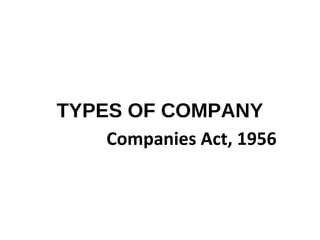
types of companies
- 1. TYPES OF COMPANY Companies Act, 1956
- 3. TYPES • From the point of view of Incorporation. • From the point of view of Liability. • From the viewpoint of Nationality. • From the view point of Public Interest.
- 4. From the point of view of Incorporation. Types of Companies CHARTERED STATUTORY REGISTERED
- 5. CHARTERED COMPANY • Historically, most of the early companies were set up through a Royal Charter. • For example, the East India Company, the Chartered Bank of Australia, India and China, etc., were incorporated by the grant of a special Royal Charter, • In India, this form of organization does not exist now because there is no monarchy. • Even in England, this method is rarely used now. Companies of this kind may be called chartered companies.
- 6. STATUTORY COMPANY • In this case, a special law is passed to establish the company. • This is done only in special cases when it is necessary to regulate the working of the company for some specific purposes. • Examples of such companies in India are: the Industrial Finance Corporation, the Life Insurance Corporation of India, the Air India, etc.
- 7. REGISTERED COMPANY • The Companies Act, 1956, lays down procedures by which a company can be brought into existence. • Anybody who wants to incorporate a company can do so by taking necessary steps outlined therein. • By far the largest number of companies is incorporated under the Companies Act. These companies may be called registered companies.
- 8. From the point of view of Liability. TYPES UNLIMITED GUARANTEE LIMITED
- 9. ULIMITED COMPANY • Do not have any limit on the extent of liability of its members. • Liability of each member extends to whole amount of the company’s debts and liabilities. • However, the members cannot be sued upon the directly by the company's creditors.
- 10. COMPANY LIMITED BY GUARANTEE Classification Company Limited by Guarantee not Having share capital Company Limited by Guarantee Having share capital
- 11. Company Limited By Guarantee Not Having Share Capital •Memorandum Limits the member’s liability. •It is limited to the amount as may have been undertaken by MOA to contribute in the case of winding up.
- 12. Company Limited By Guarantee Having Share Capital •Memorandum Limits the member’s liability. •Moreover, liability would also extend to the unpaid value of the shares held by the member.
- 13. LIMITED COMPANY • The liability of the members of the company is limited to the amount remaining unpaid on the shares. • Hence the holders of the fully paid up shares cannot be called upon for the further contribution. • The liability of the members holding the partly paid up shares exists even if the company is in process of winding up.
- 14. From the viewpoint of Nationality. TYPES NATIONAL MULTI-NATIONAL
- 15. NATIONAL COMPANY In this case, the control and the management of the affairs of the company are to be carried out within the geographical boundaries of the country.
- 16. MULTINATIONAL COMPANY The branch is not an Independent entity and is linked up to the parent company existing in some other country.
- 17. From the view point of Public Interest. TYPES PRIVATE PUBLIC GOVERNEMENT
- 18. PRIVATE COMPANY •Section 3(l) (iii) states that Private Company is a company Which by its Articles, •Restricts the rights of the members to transfer the shares, •Limits the membership to 50, excluding the past and present employees of the company who are the members of the company, and •Prohibits the invitation to public, for subscription of shares or debentures of the company.
- 19. PUBLIC COMPANY •Section 3(l) (iii) states that Public Company is a company Which by its Articles, •Does not restrict the rights of the members to transfer the shares, •Does not limit the membership to 50, excluding the past and present employees of the company who are the members of the company, and •Invites the public, for subscription of shares or debentures of the company.
- 20. GOVERNMENT COMPANY •Defined under Section 617 of Companies Act, 1956. •It is a company in which 51% of the paid up share capital is held either by the central government or by state government or partly by both of them. •It is introduced in Companies Act, 1956, hence it will mean a company registered and incorporated under the companies Act, 1956.
- 21. PRACTICAL PROBLEMS • In a private limited Company it is discovered that there are, in fact, 54members. On an enquiry, it is ascertained that 6 of such members have been employees of the Company in the recent past and that they acquired their shares while they were still employees of the Company. Is it necessary to convert the Company into a public limited Company Ans. As per Section 3(1) (iii), a Company to be registered as a private Company must restrict its membership to 50 only. But, however, in counting this number of 50 members, employee members and ex-employee members (i.e., those who become members while in the employment of the Company but now having retired still continue to retain membership) are to be excluded. Thus, in the given case, the Company shall continue to be a private Company. There is no need for conversion.
